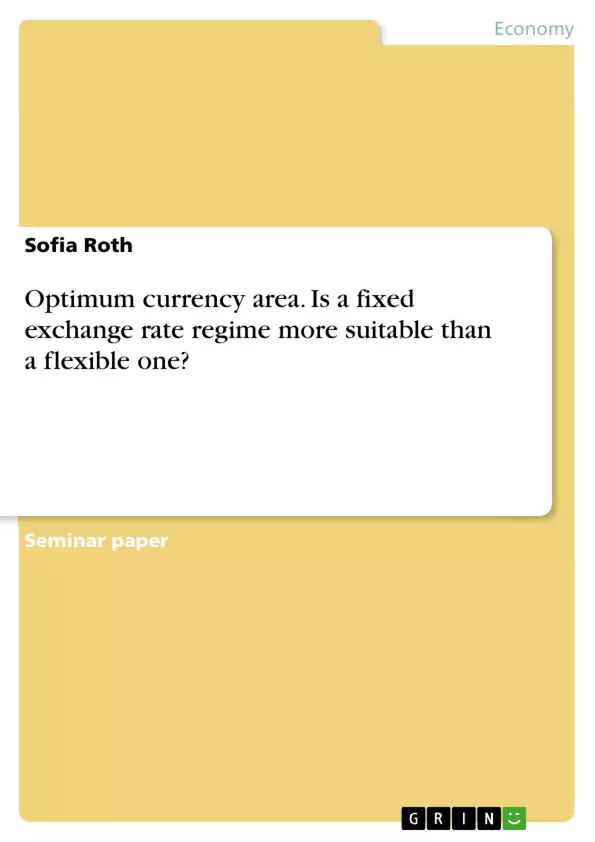This term paper outlines the theory of Optimum Currency Area (OCA), also known as an Optimal Currency Region (OCR). It also deals with the question under which conditions it is more suitable to have a fixed exchange rate regime or a flexible exchange rates regime in an OCA.
The theory of OCA was developed in the early 1960s and deals with mixed, complicated issues of international macroeconomics and "emerged from the debate on the advantages and disadvantages of fixed versus flexible exchange rate regimes". Moreover the theory "attempts to answer the question under which circumstances it is beneficiary for a country or region to constitute a common currency area with other countries or region". This question was analyzed and contributed by the pioneered work of Mundell (1961). Other contributors at the beginning of this theory were McKinnon (1962) and Kenen (1969). Their cognition were based on founding’s by Friedman (1953) and Meade (1957).
Inhaltsverzeichnis (Table of Contents)
- Introduction
- History and Development of the Theory of Optimum Currency Area
- The "pioneering Phase": from the early 1960s to the early 1970s
- Price and wage flexibility
- Mobility of factors of production including labor
- Financial market integration
- The degree of economic openness
- The diversification in production and consumption
- Similarities of inflation rates
- Fiscal integration
- Political integration
- The "Reconciliation Phase” – the 1970s
- The "pioneering Phase": from the early 1960s to the early 1970s
- The "Reassessment Phase:” – the 1980s and Early 1990s
- The first try to establish a European currency
- The end of World War II
- Creation of the European Monetary System (EMS)
- Preparation for the European Economic and Monetary Union (EMU)
- The “Empirical Phase:” – from the 1980s to today
- The first try to establish a European currency
- Fixed exchange rate and flexible exchange rate in an OCA
- To Fix or to Float: the influence of Friedman in the 1950s
- Mundell's models
- OCA with stationary expectations
- OCA with international risk sharing
- Extensions of the OCA theory
- Fixed versus flexible exchange rates
- The case for flexible exchange rates
- Monetary Policy Autonomy
- Trade Balance Adjustments
- The case for fixed exchange rates
- Monetary Discipline
- Speculation
- Uncertainty
- Trade Balance Adjustments
- The case for flexible exchange rates
Zielsetzung und Themenschwerpunkte (Objectives and Key Themes)
This term paper focuses on the theory of Optimum Currency Area (OCA), also known as Optimal Currency Region (OCR), and explores the question of when a fixed exchange rate regime is preferable to a flexible exchange rate regime within an OCA. The paper delves into the historical development of the OCA theory and its various phases, while also analyzing the advantages and disadvantages of each exchange rate system.
- History and development of the OCA theory
- Key criteria for forming an OCA
- Advantages and disadvantages of fixed exchange rates
- Advantages and disadvantages of flexible exchange rates
- Optimal exchange rate regime for an OCA
Zusammenfassung der Kapitel (Chapter Summaries)
The paper begins with an introduction to the OCA theory, outlining its historical development and significance. It then delves into the "pioneering phase" of the theory, exploring the eight key criteria for forming an OCA, such as price and wage flexibility, mobility of factors of production, financial market integration, and the degree of economic openness.
The paper continues by examining the "reconciliation phase" of the OCA theory, which took place in the 1970s. This section likely discusses the shift from fixed to flexible exchange rates in the context of the breakdown of the Bretton Woods System.
Next, the paper explores the "reassessment phase," focusing on the 1980s and early 1990s, and the "empirical phase" from the 1980s to the present. These sections probably delve into the attempt to establish a European currency and the creation of the European Monetary System (EMS). Additionally, they may analyze the real-world application of the OCA theory and its impact on economic integration.
Finally, the paper examines the benefits and drawbacks of fixed versus flexible exchange rates. This section likely presents arguments in favor of each system, such as the advantages of monetary policy autonomy with flexible rates and the benefits of monetary discipline with fixed rates.
Schlüsselwörter (Keywords)
The core topics explored in this paper are the theory of Optimum Currency Area (OCA), Optimal Currency Region (OCR), fixed exchange rate regimes, flexible exchange rate regimes, monetary policy autonomy, monetary discipline, trade balance adjustments, and the historical phases of the OCA theory, including the pioneering, reconciliation, reassessment, and empirical phases.
- Quote paper
- Sofia Roth (Author), 2011, Optimum currency area. Is a fixed exchange rate regime more suitable than a flexible one?, Munich, GRIN Verlag, https://www.grin.com/document/201741



